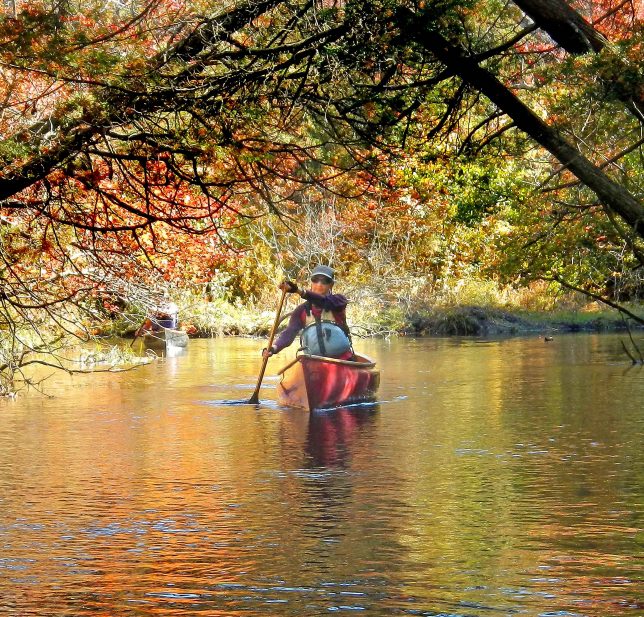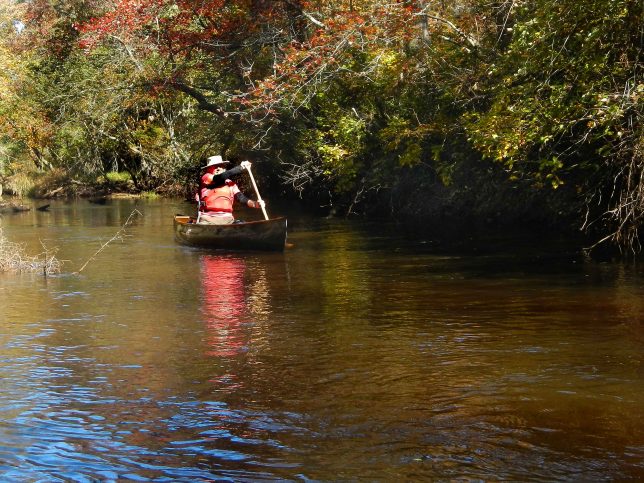By Marc Ornstein
One thing I’ve learned while teaching FreeStyle is that you can’t teach turns and maneuvers if your “students” aren’t proficient at keeping their canoes consistently going straight, and there are very few who are. Several years ago, we held the first Pine Barrens Functional FreeStyle Canoe Symposium. This particular event runs on a tighter than usual schedule and at our very 1st morning session we jumped right into teaching the various maneuvers. We had assumed our students had solid forward strokes; that they could travel on the straight and narrow. You know what they say about assuming. Even most of our “experienced” students needed a refresher on going straight, before we could move on to turns. We’ve since revised the program so that the 1st session is a forward stroke clinic.
Regardless of what class I am teaching or what topic someone has asked for help with, I generally begin by asking them to paddle in a straight line, away from me, towards a target and back again. While they are paddling, I’m observing. I am looking to see how straight their canoe is tracking. I’m studying all aspects of their forward stroke and their J or other correction. With very few exceptions, there is room for significant improvement and a bit of time spent refining these basics, pays off handsomely when we begin working on maneuvers.

If the canoe is not running straight to begin with, it is nearly impossible to learn the subtleties of turns/maneuvers. What appears to be a perfectly executed initiation might fail because prior to the initiation the canoe was already turning the opposite way. Conversely, a poorly executed initiation might appear to be successful, only because prior to the initiation the canoe was already turning in the desired direction. Perhaps even more to the point is that Freestyle is, 1st and foremost, about effective and efficient paddling. There is nothing effective or efficient about a canoe that wanders and constantly needs to be coaxed back on course.
In a perfect world, there would be a (longitudinal) slot in the center of the canoe, just forward of the paddler. (In the case of a tandem canoe there would be two slots, one in front of each paddler.) The paddler would reach forward, place the paddle through the slot, into the water and pull straight back. Barring wind, current or other outside forces, the canoe would go straight ahead. In the real world we are forced to paddle on one side of the canoe or the other. The paddle, being offset from the center, pulls the paddle side (also known as the on side) of the canoe forward with greater force than the off side (side opposite the paddle), causing the canoe to turn toward the off side. We refer to this as yaw.
When the paddler’s grip hand is inboard of the gunwale, the shaft and blade must be at an angle, pointing away from the canoe, in order to reach the water. This places the blade further away from the side of the boat and from that imaginary slot or centerline. The further the blade of the paddle is from that centerline the more it will cause the canoe to turn (yaw). Freestyle instructors constantly preach “keep your hands stacked” and “vertical shaft” meaning keep your grip hand stacked directly over your shaft hand. (This requires extending your grip hand out over the gunwale which may seem awkward at first but becomes natural with practice.) Doing so will ensure that the blade is as close to the side of the boat as possible. Freestyle stresses keeping the paddle shaft as vertical as possible during most of the forward stroke. Skilled paddlers will sometimes extend their grip hand even further out than their shaft hand, allowing the paddle blade to reach partially beneath the boat and closer to the centerline. The closer the blade is kept to the centerline, the less turning force it imparts and the less correction that will be needed later. It is also important to keep the entire or nearly the entire blade in the water through the entire forward stroke (and the correction phase). A blade that is only partially in the water is not effective or efficient.

Even though the side of the canoe is curved, the path of the paddle should be straight. In the case of a solo paddler (sitting or kneeling near the center of the canoe) it means the placement of the paddle, at the catch or the beginning of the stroke, needs to be a bit away from the hull so that it may come straight back, past the widest part of the boat. If the paddle is allowed to follow the curvature of the hull, it will, in effect, be performing a mild sweep and will cause the canoe to turn away.
The power portion of the stroke must be kept short and forward. The paddler should reach forward for the catch as far as can be accomplished without significant bending or bobbing at the waist. This is best accomplished by rotating the torso and the onside shoulder forward. Power ends as the paddle passes the knee and is then sliced out for the recovery and the next stroke. Carrying power further back will, once again, cause the canoe to turn toward the off side.
If the forward stroke is to be followed by a J or similar correction stroke, the blade must be allowed (with minimal if any power) to continue as far back as one can comfortably reach before executing the J (or other correction). If the forward stroke was properly done, minimal correction should be necessary. Any correction requires the expenditure of additional energy and robs the canoe of forward momentum. Anything the paddler can do to minimize the need for or amount of correction necessary is a win.
The proper use and execution of the J stroke is a subject of its own and will be the topic of another article.
Here’s a video to show what “going Straight” looks like, at live speed and at 1/4 speed: